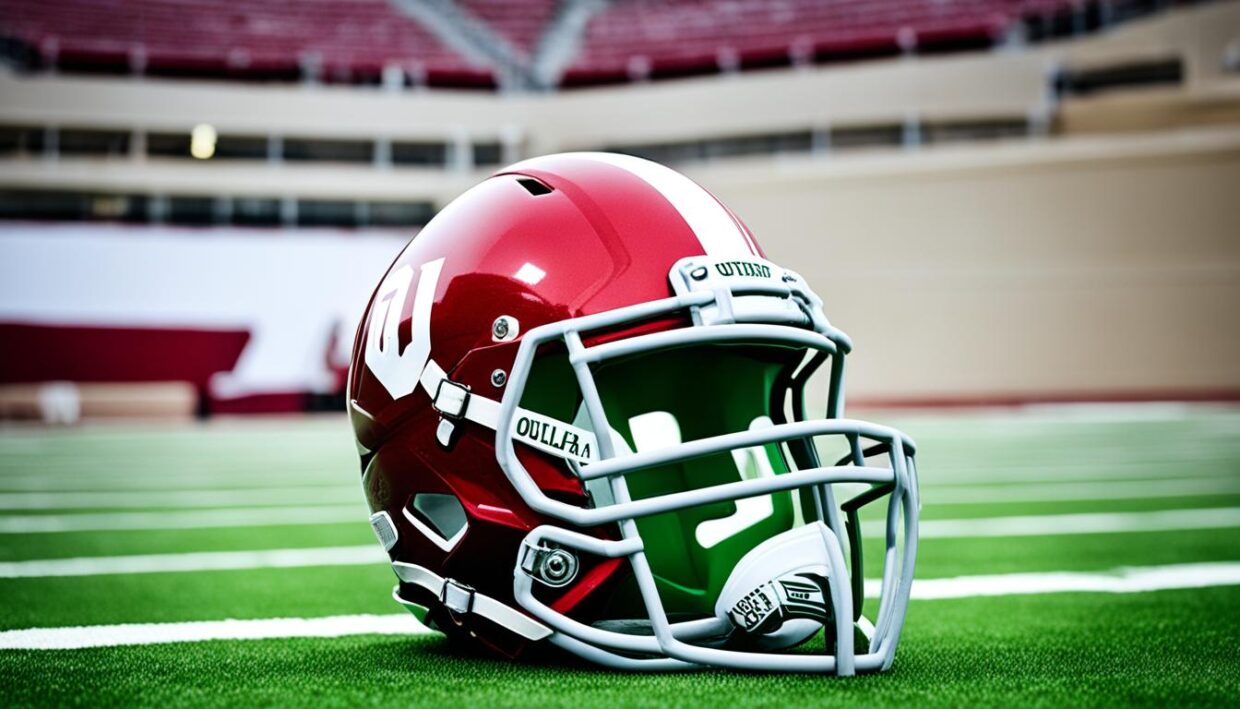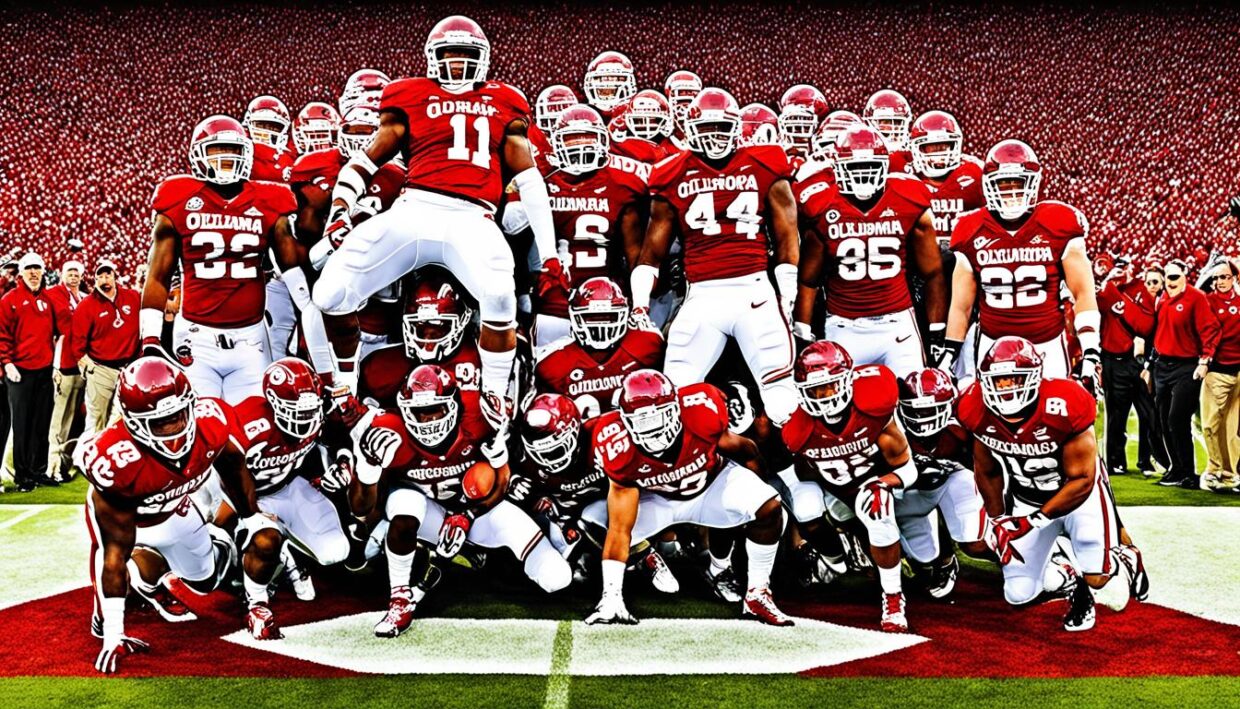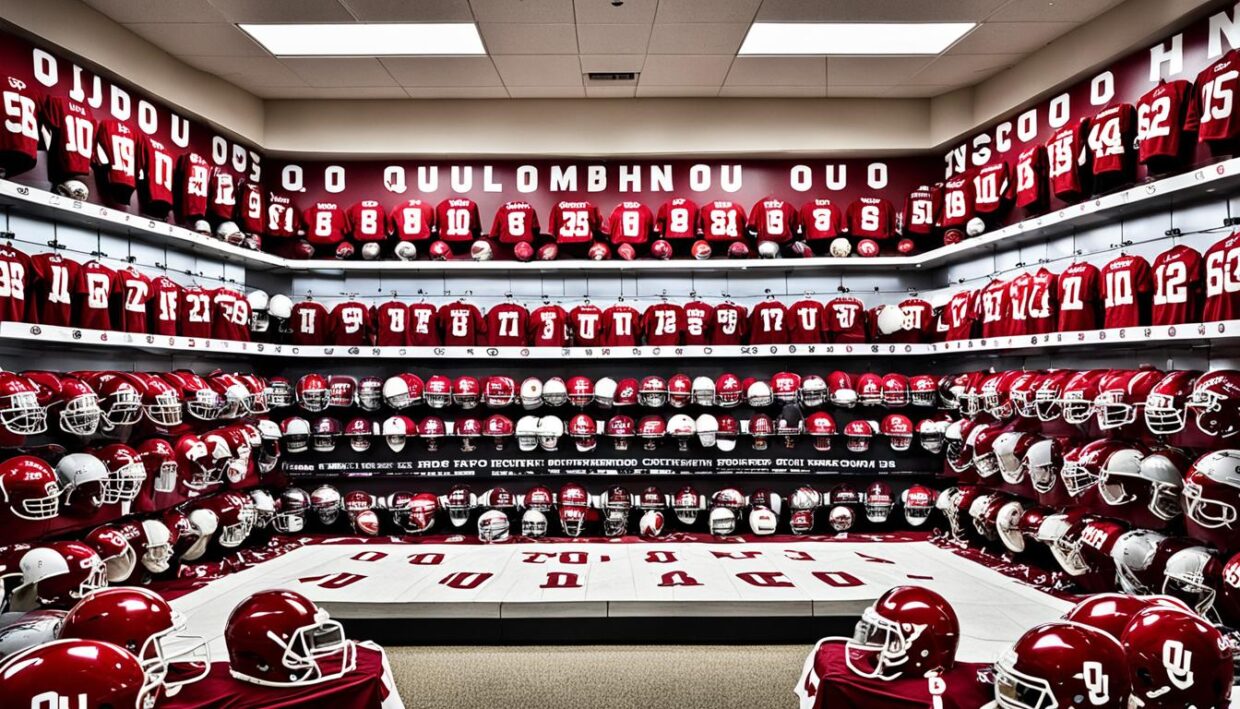
“Success is not the key to happiness. Happiness is the key to success. If you love what you are doing, you will be successful.” – Albert Schweitzer
The University of Oklahoma’s football program stands as a testament to this belief, demonstrating that passion and commitment yield remarkable results. Known for its rich history and tradition, Oklahoma Sooners football has long been a powerhouse in college football and a dominant force within the NCAA. With an all-time record of 944 wins, 341 losses, and 53 ties, the Sooners have established themselves as a formidable contender in the Big 12 Conference. Their legacy is highlighted by seven claimed national championships, over 50 conference titles, and numerous accolades that span decades.
As we delve deeper into the storied past of this remarkable program, we will explore pivotal figures and unforgettable moments that have shaped the identity of Oklahoma football. From the earliest days on the field to groundbreaking coaching strategies that revolutionized the game, each chapter tells a story of determination and unparalleled success that resonates within the hearts of fans and athletes alike.
Key Takeaways
- Oklahoma Sooners football boasts an impressive all-time record of 944–341–53 (.725).
- The team has claimed seven national titles and over 50 conference championships.
- OU has participated in multiple College Football Playoff appearances, reaching the semi-finals in various years.
- The team has produced numerous Heisman Trophy winners, enhancing its legacy in college football.
- The Sooners have won 14 out of 27 Big 12 Conference titles, showcasing their dominance in the league.
Introduction to Oklahoma Sooners Football
The Oklahoma Sooners football program originated in 1895 at the university of oklahoma and has evolved to become a formidable force in college football. The early days of this program saw officials grappling with the definition of “Sooners,” a term initially linked with illegal land claims during the Oklahoma land rush. Over time, this term transformed into a badge of honor for a proud football tradition.
The official school colors, crimson and cream, have been part of OU’s identity for over a century, symbolizing the pride that the Oklahoma Sooners football team inspires in its passionate fan base. The fight song “Boomer Sooner,” crafted in 1905, exemplifies the spirit that resonates within the community as they rally behind their team.
As the program progressed, the Sooners welcomed various mascots, showcasing their rich history and tradition. Mex the Dog, wearing a red sweater emblazoned with the letter “O,” delighted fans during games from 1915 until 1928. This affection for their mascot prompted the university of oklahoma to close for Mex’s funeral, highlighting the bond between the community and the imagery of the team. The current mascot, the Sooner Schooner, has been a beloved sight at games since 1980, offering a glimpse into the university’s commitment to tradition.
Today, the Oklahoma Sooners football team stands as a prestigious program within the Big 12 Conference and nationally, fostering an environment of competitive spirit while producing championship-caliber teams. The legacy established continues to thrive, showcasing the dedication of players, coaches, and fans alike.

The Early Years of OU Football
The Oklahoma Sooners football program began its journey on December 14, 1895, marking the start of a legacy in college football. This inaugural game resulted in a shutout loss against a team from Oklahoma City, yet it set the stage for what would become a historic program. The early years saw various challenges as the program transitioned from informal gatherings to a more structured football entity.
The First Game and Beginnings
The first game, while not a victory, sparked interest and excitement around football in Oklahoma. It established the foundation for a passion that would grow tremendously. Over the next few years, games became more organized, paving the way for the formation of a collegiate football program by setting clear objectives and expectations. This foundational period was crucial in developing the identity of Oklahoma Sooners football.
Significant Early Coaches
Early coaching efforts were instrumental in shaping the direction of the Sooners. Coaches like Vernon Louis Parrington took on the significant task of increasing the team’s competitiveness and visibility in the realm of college football. Under their leadership, the program began to develop a winning record, showcasing the potential of the team in the early years. Their dedication laid the groundwork for the illustrious coaching history that would follow.

Bennie Owen: The Architect of OU Football
Bennie Owen played a pivotal role in the establishment of the Oklahoma Sooners football program, serving as head coach from 1905 to 1926. His coaching tenure witnessed remarkable changes in the sport, especially with the legalization of the forward pass in 1906. This rule change allowed Owen to innovate and recruit players who could embrace a more dynamic style of football, significantly shaping the identity of Oklahoma Sooners football.
Owen’s Achievements and Coaching Tenure
During his 22 years of coaching, Bennie Owen led the Sooners to four undefeated seasons and secured three conference titles. His coaching record of 122-54-16 reflects a successful era that laid the groundwork for future achievements. Notably, in 1918, the impact of World War I resulted in a shortened schedule for the Sooners, while the 1918 influenza pandemic affected many of Owen’s former players. Despite these challenges, Owen’s determination contributed to the resilience of the program.
Establishing a Winning Tradition
Owen’s influence extended beyond the win-loss record. He spearheaded fundraising efforts that resulted in the development of crucial campus facilities like the football stadium and the Oklahoma Memorial Union. His dedication to both athletics and education made a lasting impression on the university community. In 1955, the University of Oklahoma celebrated his contributions with a dinner, recognizing his foundational role in shaping the Sooners’ athletic legacy.

The Wilkinson Era: A Golden Age
The coaching career of Bud Wilkinson at the University of Oklahoma transformed the landscape of college football. His tenure from 1947 to 1963 marked an era characterized by extraordinary achievement and remarkable consistency. Oklahoma Sooners football gained national prominence under his leadership, establishing a legacy still revered today.
Unprecedented Winning Streaks
One of the crowning achievements of Bud Wilkinson’s coaching was the astonishing 47-game winning streak, a record in Division I football that remains unmatched. Between 1953 and 1957, Wilkinson’s teams showcased a level of play that was simply unparalleled, demonstrating exceptional skill, teamwork, and strategy. This streak contributed significantly to his impressive coaching record of 145 wins against just 29 losses and 4 ties.
Wilkinson’s National Championships
Bud Wilkinson led the Oklahoma Sooners to three national championships in the years 1950, 1955, and 1956. His success extended beyond just championships; his teams secured a total of 14 conference titles. The ability to maintain such a high winning standard over twelve consecutive seasons without a single loss in conference play highlights the coaching acumen and competitive spirit instilled in his players. This remarkable ability to keep the team performing at peak levels established Wilkinson as one of the NFL’s most legendary coaches.

| Year | Achievements |
|---|---|
| 1950 | National Championship Win |
| 1955 | National Championship Win |
| 1956 | National Championship Win |
| 1947-1958 | 12 Consecutive Seasons Without Conference Loss |
| 1948-1958 | 107 Wins, 8 Losses, 2 Ties |
Life After Wilkinson: Transitioning Through Coaches
The legacy left by Bud Wilkinson at the University of Oklahoma set a high standard for the Oklahoma Sooners football program. Following his impressive run from 1947 to 1963, which included a remarkable record of 145 wins, 29 losses, and 4 ties, navigating the aftermath required deft handling and strategic foresight. The coaching changes that followed Wilkinson’s departure exposed the program to both challenges and opportunities, crucial for maintaining the momentum established during his tenure.
Challenges and Changes in Coaching Staff
With Wilkinson’s record of three national championships and 14 conference titles, expectations were high. The transition period saw coaches like Gomer Jones step in, but they struggled to replicate the same success. Jones’ era reflected the challenges faced by the Oklahoma Sooners football program as they adjusted to new coaching philosophies and styles.
Several coaching changes marked this period, with each new leader bringing their approach to build on the tradition Wilkinson established. Stability became an essential focus for the University of Oklahoma, as each coaching transition posed questions about future success and recruitment strategies. Ensuring a cohesive program amidst these coaching changes remains vital to rebuilding a winning culture within the ranks of Oklahoma Sooners football.

Barry Switzer: Revolutionizing OU Football
Barry Switzer’s influence on Oklahoma Sooners football cannot be overstated. His introduction of the wishbone offense in 1970 significantly changed the dynamics of the team’s strategy, leading to unprecedented success on the field. The unique approach combined power running with versatile options, proving to be an effective style that challenged opponents and garnered the attention of the entire college football landscape.
Implementing the Wishbone Offense
The wishbone offense, originally conceived by Emory Bellard, featured three running backs and allowed the quarterback to make crucial decisions based on defensive formations. Barry Switzer embraced this innovative approach, utilizing it to maximize the strengths of his talented roster. Coaches widely recognized the offense’s potential, and upon its implementation, Oklahoma Sooners football quickly evolved into a powerhouse during Switzer’s tenure. His commitment to studying and mastering the system made a lasting impact, resulting in unique strategies that remained effective for years.
Switzer’s National Titles and Championships
Under Barry Switzer’s leadership, the Oklahoma Sooners achieved remarkable milestones, including national championships in 1974 and 1975. Switzer’s teams showcased exceptional talent and discipline, with standout players consistently earning All-American honors. Years of successful seasons culminated in a culture of excellence that shaped the identity of Oklahoma football. Switzer’s legacy not only highlighted the Sooners’ prowess on the field but contributed to their esteemed place in college football history.

Oklahoma Sooners Football: Achievements and Records
The rich history of Oklahoma Sooners football is punctuated by numerous achievements and a legacy of excellence. This program has consistently demonstrated its prowess on the field, establishing itself as a dominant force in college football. With a robust record in bowl games and a strong showing in conference championships, the Oklahoma Sooners continue to elevate their status within the NCAA landscape.
Historical Overview of Bowl Games
As one of the premier programs in college football, the Oklahoma Sooners have participated in an impressive array of bowl games. Their all-time bowl record stands at 31 wins and 25 losses. Since 2001, the team has achieved a record of 9-11 in bowl contests, showcasing a mixture of triumphs and challenges with a bowl game-winning percentage of .553. Despite these efforts, the Sooners have yet to secure a victory in four College Football Playoff appearances, emphasizing the competitive nature of postseason football.

Conference Championships and Titles
The Oklahoma Sooners football program has a storied history, particularly in conference play. They’ve won 13 Big 12 conference championships since 2001, maintaining an impressive record without any losing seasons in conference play in the same timeframe. The Sooners stand out as the only team in the FBS to achieve at least eight wins every year since 2001, further solidifying their reputation for consistency. With a total of 50 conference titles throughout their history, Oklahoma’s competitive spirit remains evident as they strive to uphold their legacy in college football.
The Evolution of Offensive Styles
The Oklahoma Sooners football team has long been recognized for its high-octane offensive styles. This section explores the evolution from traditional schemes to modern offenses, emphasizing how these changes have impacted the program’s identity. Offensive strategies have shifted significantly over the years, moving from ground-based attacks to diverse passing games that redefine the quarterback role.
Transitioning to Modern Offenses
The transition from the classic wishbone offense to contemporary styles illustrates the adaptability of the Oklahoma Sooners football program. The wishbone, heavily relying on running plays, featured prominently in earlier decades. With an emphasis on teamwork, fullbacks demanded respect while offensive plays exploited defensive weaknesses. Notably, the distribution of plays discussed shows a blend of old and new, including the QB Keeper, Counter Play, and various passing schemes that have come to define modern offenses. The previous prominence of the wishbone showcased its strategic importance, with six out of eleven plays reflecting its influence.
Quarterbacks that Defined a Generation
Quarterbacks have played a crucial role in shaping the identity of the Oklahoma Sooners football team. Players like Baker Mayfield and Kyler Murray not only excelled but also transformed the quarterback position by introducing dynamic skill sets tailored to modern offensive styles. Their ability to lead high-scoring offenses resonates in the program’s accolades. The average yards gained in plays such as the Passing Game and Play Action Pass reflect the explosive nature of their gameplay, often resulting in big gains or touchdowns. A standout moment includes the longest pass play dissected in this analysis, a remarkable 74-yard connection from Josh Heupel to Antwone Savage.

The strategies employed under the guidance of innovative coaches have placed Oklahoma at the forefront of college football. The evolution from the Triple Option to the Spread Option and beyond encapsulates a journey marked by significant changes in offensive philosophy. By integrating powerful run schemes with advanced passing concepts, the Sooners continue to redefine the game while honoring their rich legacy.
Heisman Trophy Winners at the University of Oklahoma
The University of Oklahoma has a proud history of excellence in college football, highlighted by the achievement of seven Heisman Trophy winners. This prestigious award, recognizing the best player in college football, has solidified the Oklahoma Sooners football program’s reputation on the national stage, contributing significantly to its legacy in college football.
Profiles of Notable Heisman Winners
Among the most notable winners are:
- Billy Vessels (1952): The first Heisman Trophy winner from OU, he rushed for 1,072 yards and 17 touchdowns.
- Steve Owens (1969): Known for his impressive 1,523 rushing yards and 23 touchdowns.
- Billy Sims (1978): Set a Big Eight record with 1,762 rushing yards in a single season.
- Jason White (2003): His remarkable season included 40 touchdown passes.
- Sam Bradford (2008): Achieved a passing efficiency record with 4,720 yards and 50 touchdowns.
- Baker Mayfield (2017) and Kyler Murray (2018): Both were honored in consecutive years, showcasing OU’s dominant quarterbacks.

Impact on Oklahoma’s Legacy in College Football
The success of these Heisman winners played a significant role in shaping the OU football program. The Sooners rank alongside Notre Dame and Ohio State as schools tied for the most Heisman Trophies won. With four trophies awarded within a remarkable span of 16 years, Oklahoma’s impact on college football continues to be felt.
The achievements of individual players not only garnered personal accolades but also enriched the overall legacy of Oklahoma Sooners football, cementing its position within the annals of college football history. Through these remarkable athletes, the university has showcased its ability to cultivate exceptional talent, further establishing the school’s reputation as a powerhouse in the world of college athletics.
Recent Developments in OU Football
Under the leadership of Brent Venables, Oklahoma Sooners football is navigating a pivotal moment. The coaching staff has been actively refining strategies to prepare for the upcoming challenges in the Southeastern Conference. This phase brings a blend of tradition and innovation, as the team aims to build on its storied legacy while adapting to new dynamics in college football.
Current Coaching Staff and Leadership
The current coaching staff reflects a blend of experienced mentors and emerging talents, crucial as the Sooners transition to the SEC. Notable highlights include:
- Two players from Oklahoma selected for the Preseason All SEC First Team, showcasing the talent within the squad.
- Oklahoma predicted to finish eighth in the Southeastern Conference Preseason Media Poll, indicating competitive expectations.
- The departure of both offensive and defensive coordinators during the offseason, signaling a fresh start.
- The approval of Curtis Lofton’s new title as general manager by the University of Oklahoma Board of Regents, underlining an evolving administrative structure.
- Key player representation at the SEC football media days by Danny Stutsman, Billy Bowman, and Jackson Arnold, enhancing visibility and engagement.
Recruitment efforts are also gaining momentum. Oklahoma had five verbal commits, indicating progress in attracting new talent. The coaching staff extended ten offers, leading to nine visitations. Remarkably, a conversion rate of 29.4% reflects successful engagement with recruited players. With a total of 17 players covered, there’s a solid foundation for bolstering team strength.

This combination of strategic hires and proactive recruitment reflects Brent Venables’ commitment to evolving the program while honoring its legacy. The Oklahoma Sooners football team’s trajectory aims not only at the upcoming SEC challenges but also at reclaiming its role as a powerhouse in college football.
Future of Oklahoma Sooners Football
The Oklahoma Sooners football program is poised for an exciting transformation as the team prepares for its SEC transition. This move represents a significant shift in the landscape of college athletics, setting the stage for competitive challenges and unparalleled opportunities. As the Sooners immerse themselves in the Southeastern Conference, they will face an array of premier teams and strengthen their reputation within the realm of college football.
Implications of SEC Transition
With the SEC transition on the horizon, Oklahoma Sooners football must adapt to new dynamics. This adaptation is crucial for maintaining competitiveness at a championship level. Teams in the SEC are known for their robust talent pools and high-stakes matchups. Brent Venables, head coach, emphasizes upgrades across various facets of the program, irrespective of conference alignment.
In preparation for the SEC, Oklahoma has already secured standout recruits such as David Stone. His current rating on 247 Sports exceeds several former acclaimed defensive linemen, illustrating the high caliber of talent OU aims to attract. Stone’s decision to join OU over prestigious schools such as Miami and Oregon showcases the Sooners’ appeal even amidst a competitive recruiting landscape.
The shift to the SEC will also affect scheduling. The conference’s anticipated adoption of an eight-game format calls for strategic planning of nonconference games. Oklahoma’s 2024 schedule already includes challenges against Temple and Tulane, with more matchups to be announced. Maintaining a balanced yet competitive schedule will be vital for the Sooners as they navigate through SEC waters.
As Oklahoma approaches essential matchups, such as their historic rivalry with Nebraska, the need for consistent performance and adaptability grows paramount. This will not only bolster OU’s position in the SEC but also serve as a platform for the future of college football in the region. Monitoring this evolution will provide a blueprint for how traditional programs can thrive in new environments.

| Recruit Name | 247 Sports Rating | Ranking | Position | Offers |
|---|---|---|---|---|
| David Stone | .9968 | No. 10 overall, No. 3 defensive tackle | Defensive Tackle | Miami, Michigan State, Oregon, Texas A&M, 30+ others |
| Williams Nwaneri | .9987 | Not Committed | Defensive Lineman | Committed to Missouri |
Rivalries That Defined Sooner Football
The rivalry culture surrounding Oklahoma Sooners football creates a vibrant backdrop to their storied history. Among these heated competitions, the matchups against Texas and Oklahoma State remain particularly significant. Each game carries not only competitive weight but also cultural importance, leaving an indelible mark on both institutions.
Key Matchups in OU’s History
The Bedlam rivalry with Oklahoma State showcases a long-standing contention, with Oklahoma leading the series at 91 wins, 19 losses, and 7 ties. This rivalry has seen thrilling moments, including overtime clashes in 2012 and 2014, alongside high-scoring contests like the 61-41 shootout in 2008 and the nail-biting 31-28 victory in 1988. During a dominant period from 1946 to 1957, the Sooners went on an impressive run, winning 19 straight games against Oklahoma State.
The significance of key matchups enhances Oklahoma’s football legacy. The 1976 Bedlam matchup marked a pivotal moment with Oklahoma State defeating the No. 5 Sooners 31-24. Barry Sanders, one of Oklahoma State’s most celebrated players, never managed to defeat Oklahoma during his college years, adding another layer to the rivalry’s narrative.
The Red River Rivalry against Texas dates back to October 10, 1900, where Texas won the inaugural game 28-2. Notable encounters, such as the latest meeting on October 7, 2023, saw Oklahoma claim a close 34-30 victory, bringing their record against Texas to 51 wins against Texas’s 63 victories overall. The backdrop of these fierce matchups remains the Cotton Bowl, a cherished venue since 1932. The Golden Hat trophy symbolizes victory for the winning team until the next showdown, embodying the rivalry’s spirit.

The Role of Football Recruiting in OU’s Success
Football recruiting has played a pivotal role in the Oklahoma Sooners football program’s success. The ability to attract elite talent has been a cornerstone since the inception of the team. As coaching strategies have evolved, so have the methods employed to scout and recruit players. Modern football recruiting involves leveraging technology and social media, enhancing outreach to prospects across the nation.
Recruiting Strategies Over the Years
Oklahoma’s recent recruiting activity showcases impressive results. In just 30 days, the Sooners secured seven commitments, consisting of four players from the 2025 recruiting cycle, one from the 2027 class, and two transfers from the portal. This aggressive approach is indicative of a concerted effort to bolster the roster moving forward, particularly with a focus on maintaining a competitive edge in college football.
The Sooners’ 2025 recruiting class ranks in the top six nationally and second in the Southeastern Conference. This class features 14 total commitments, with a significant majority being four-stars. Notably, defensive backs like Marcus Wimberly and Maliek Hawkins showcase the emphasis on athleticism and skill. Wimberly stands out as a top-five player in Arkansas, while Hawkins holds a strong position in Texas.
The integration of transfer players has also contributed to the Sooners’ success, as evidenced by their 21st national ranking for the current incoming class. Players like Branson Hickman and Jermayne Lole represent a calculated approach to strengthening both the offensive and defensive lines.
Significant changes in recruiting leadership have occurred, with Brent Venables focusing on holistic team building. Under his guidance, Oklahoma’s defense improved drastically from 2022 to 2023, underscoring the importance of aligning recruitment strategies with team performance goals. Venables emphasizes commitment from recruits and has seen some decommitments, though this reflects a broader strategy towards achieving long-term success rather than immediate gains.
Overall, the integration of innovative practices, strategic partnerships, and a focus on player development solidify Oklahoma Sooners football’s reputation. As the program looks to the future, the commitment to excellence in football recruiting remains a critical factor in maintaining their storied legacy.

Fan Culture and Community Engagement
The fan culture surrounding Oklahoma Sooners football is a significant aspect of the program’s identity, deeply intertwined with the Norman community. This vibrant connection enhances not only the overall game-day experience but also fosters a sense of belonging among fans and players alike. Community engagement plays a critical role in building this atmosphere of enthusiasm and support, setting the stage for unforgettable moments on game day.
Support from the Norman Community
Support from the Norman community has been integral to the Oklahoma Sooners’ football program. Local businesses often partner with the team, hosting events and offering promotions that draw fans closer to their beloved Sooners. With 142 consecutive sellout games and a stadium capacity of 83,911, the unwavering loyalty of the fan base becomes clear. The community’s dedication is evident during events like Unity Games, where all sports teams don black jerseys to symbolize solidarity and pride.
Impact of Fans on Home Games
The atmosphere during home games at Gaylord Family Oklahoma Memorial Stadium reflects the passion of the fans. While the energy may differ compared to SEC or Big Ten stadiums, efforts to enhance the game-day experience continue to evolve. Under the guidance of event coordinators with experience from the NBA and NHL, game days now include innovative elements like LED lights that respond to impactful plays, creating a lively and engaging experience for attendees.

| Metrics | Details |
|---|---|
| Consecutive Sellout Games | 142 |
| Stadium Capacity | 83,911 |
| Community Engagement Initiatives | Unity Games, Support from Local Businesses, Voting Education Programs |
| NIL Opportunities Created | 130 OU athletes benefited through Crimson and Cream Collective |
Oklahoma Sooners Football in Pop Culture
The influence of Oklahoma Sooners football transcends the world of sports. This cultural phenomenon finds representation in various forms of media and film. The famed fight song, “Boomer Sooner,” written in 1905 by Arthur M. Alden, has become a staple at games and events, resonating with fans and establishing a connection beyond the gridiron.
Representation in Media and Film
Media representation of Oklahoma Sooners football showcases its significance within American pop culture. The fight song is played between 70 and 90 times during a game, reinforcing the energy and enthusiasm of the fans. An iconic moment occurred in 1983 when the team scored 15 unanswered points after the band had played “Boomer Sooner” around 300 times during a game where they were initially losing.
Prominent figures in media, such as professional wrestling announcer Jim Ross, have mentioned the fight song, contributing to its popularity. At Heisman Trophy presentations, crowds participate in a chant where one side yells “Boomer!” while the other responds with “Sooner!” This interaction illustrates how deeply ingrained the Oklahoma Sooners football identity is within the fabric of American sports culture.
The song’s influence extends beyond sports, having even been adapted as a national tune in Albania. Such examples reflect the program’s broader impact on both local and international stages, reinforcing the Oklahoma Sooners football tradition as a vibrant element of pop culture.

The relationship between Oklahoma Sooners football and pop culture continues to evolve with each season, enhancing its legacy as not just a sports entity, but a vital part of cultural dialogue in American society.
Conclusion
The journey of Oklahoma Sooners football showcases a legacy rich with tradition, notable achievements, and a commitment to excellence that has defined the program for over a century. From the pioneering days under Bennie Owen to the dynamic transformations driven by coaches like Barry Switzer and Bob Stoops, this football program has consistently set a high standard in college athletics. Recent performances illustrate an upward trajectory, with players like Dillon Gabriel emerging as standout leaders, and a promising season ahead is on the horizon.
The impressive improvements made in close games during the 2023 season, alongside the offensive talent demonstrated by players like Gavin Sawchuk and Jalil Farooq, highlight the rebuilding efforts of the coaching staff. However, challenges remain, particularly concerning offensive line performance and the need for defensive stability. The addition of promising newcomers and the strengths of returning players signal a potential resurgence, paving the way for future success.
As the Oklahoma Sooners navigate their transition into the SEC, fans and the community are invited to remain steadfast supporters of this program. By upholding and contributing to the legacy built over the years, they fuel the aspirations for greater accomplishments. The future of Oklahoma Sooners football appears bright, and with continued dedication, the program can extend its reign as a powerhouse in college football.



















Be the first to leave a comment